The Map as Art: Contemporary Artists Explore Cartography, by Katharine Harmon with essays by Gayle Clemans (available on Amazon UK and USA.)
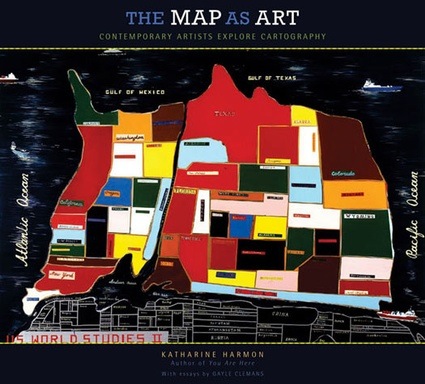 Princeton Architectural Press writes: Maps can be simple tools, comfortable in their familiar form.
Princeton Architectural Press writes: Maps can be simple tools, comfortable in their familiar form.
Or they can lead to different destinations: places turned upside down or inside out, territories riddled with marks understood only by their maker, realms connected more to the interior mind than to the exterior world. These are the places of artists’ maps, that happy combination of information and illusion that flourishes in basement studios and downtown galleries alike. It is little surprise that, in an era of globalized politics, culture, and ecology, contemporary artists are drawn to maps to express their visions. Using paint, salt, souvenir tea towels, or their own bodies, map artists explore a world free of geographical constraints.
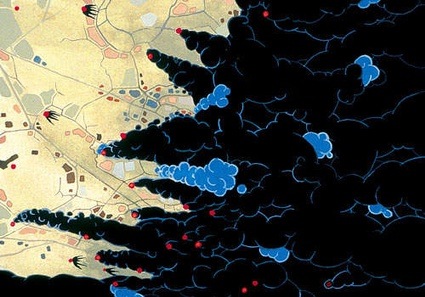 Sarah Trigg, Frame 3, 2003
Sarah Trigg, Frame 3, 2003
The British Library in London is running until mid-September Magnificent Maps: Power, Propaganda and Art . The stunning exhibition demonstrates that ancient maps were far more than two-dimensional representation of geography, they were also instruments to intimidate, educate, or inspire pride. If that wasn’t enough for a piece of paper, each of them also ventured into artistic territory.
Today’s cartography is far more composed, and eager to present itself as objective. However, Harmon’s book establishes in 360 maps that maps, plans, atlases and other topographical depiction still inspire artists.
Artists play with both the material and the content of the map. Paper plans are all over the book but so are maps made of artist’s hair, drawn on the body, printed onto the sand or turned into large-scale installations. Some maps have a clear activist agenda, others are infused with mental visions, covered with alien-abduction sites, etc.
Although the book presents mostly map art from the past two decades, the introduction has a brief (way too brief) timeline that inventories some of the most famous artists who have used maps in their works, starting in the ’20s with the Surrealists’ Map of the World.
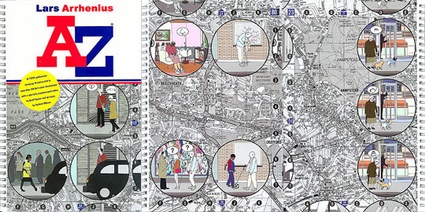 Lars Arrhenius, A-Z
Lars Arrhenius, A-Z
Map As Art is a well-documented, surprising and fascinating book. There is just enough text (lazy bloggers like me jump in horror at the sight of image-less pages): a general introduction to the volume, an essay for each chapter and a brief description of the artworks included in the book. The rest is images over images.
A few map-related works i discovered in the book:
At the heart of Enrique Chagoya‘s lithograph, Road Map lays an egocentric American point of reference that dwarves neighbours Mexico and Canada as well as the rest of the world. The map is populated with images of cultural and ethnic stereotypes as well as tankers, whales, fighter planes, religious figures, dynamite, submarines and oil wells. The two figures in the lower corners represent “Hope” and “Hopelessness”.
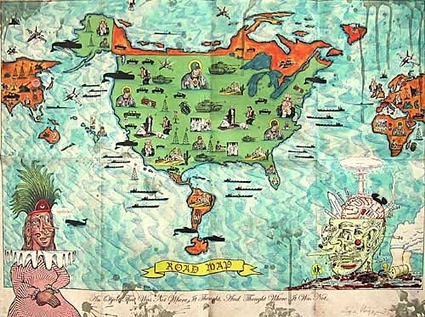 Enrique Chagoya, Road Map, 2003
Enrique Chagoya, Road Map, 2003
Ingo Günther has been using illuminated globe sculptures as mean to investigate and represent “global” issues, from access to drinking water to rain forest leftovers, from nuclear explosions to death from tobacco use, etc.
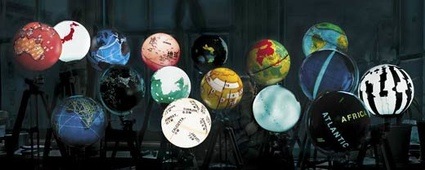 Ingo Günther, Worldprocessor, 1988-2005 (image)
Ingo Günther, Worldprocessor, 1988-2005 (image)
In June 2005 Francis Alÿs walked through divided Jerusalem leaving behind him a trail of green paint from a leaking can. His route was the Green Line, drawn on a map after the 1948 Arab-Israeli War, indicating land under the control of the new state of Israel. The Green Line has since been considerably altered, mostly by the Israeli invasion of 1967.
Btw, the best thing you can do if you’re in London,is to run and see his retrospective at Tate Modern.
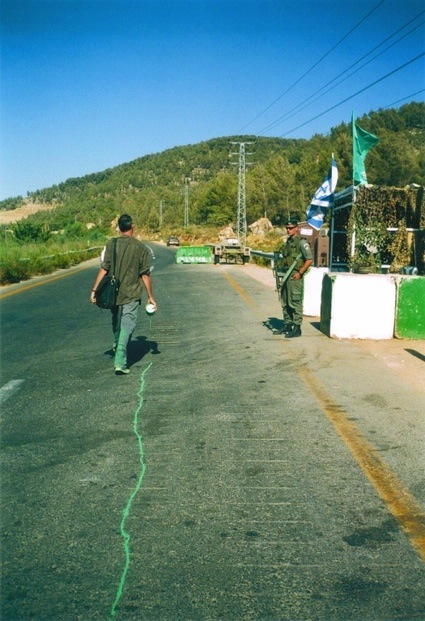 Francis Alÿs, The Green Line, 2007
Francis Alÿs, The Green Line, 2007
Abigail Reynolds‘s Mount Fear series gives a physical, tangible visualization of police statistics relating to the frequency and position of urban crimes. Each individual incident adds to the height of the model, forming a mountainous terrain.
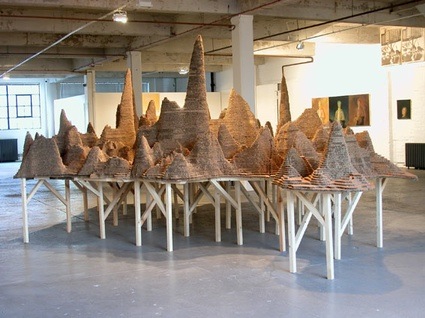 Abigail Reynolds, MOUNT FEAR East London Police Statistics for violent crimes 2002-3, 2003
Abigail Reynolds, MOUNT FEAR East London Police Statistics for violent crimes 2002-3, 2003
Harriet Russell sent herself 130 letters. Each envelope was a challenge for the Royal Mail, the address was written in an eye chart, as a colour blind test, a crosswords, on a hand-drawn map, in dot-to-dot drawings, experimental fonts, anagrams and cartoons. Only 10 failed to complete their journey back to her. (more images.)
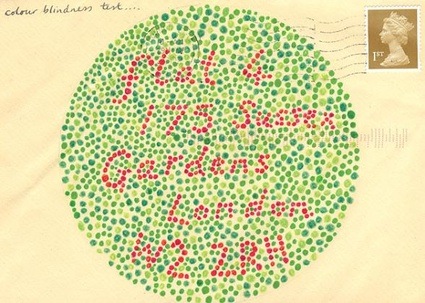
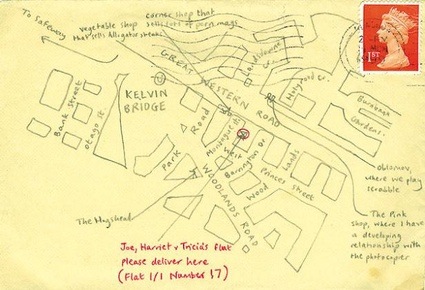
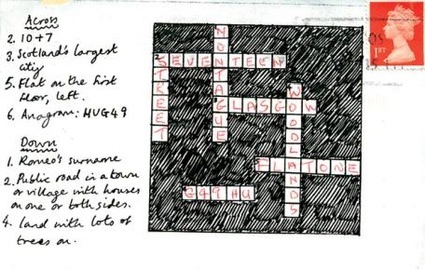
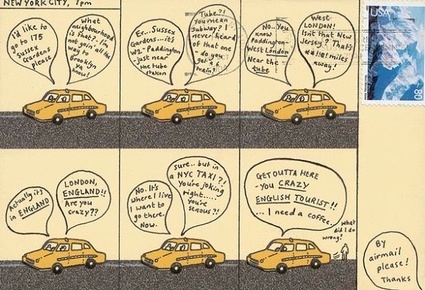 Mark Bennett draws blueprint architectural renderings of the homes of American sitcom and film characters. For cult tv series The Fugitive, he broadened his field of investigation and tracked Dr. Richard Kimble’s relentless quest for the one-armed man all over the United States.
Mark Bennett draws blueprint architectural renderings of the homes of American sitcom and film characters. For cult tv series The Fugitive, he broadened his field of investigation and tracked Dr. Richard Kimble’s relentless quest for the one-armed man all over the United States.
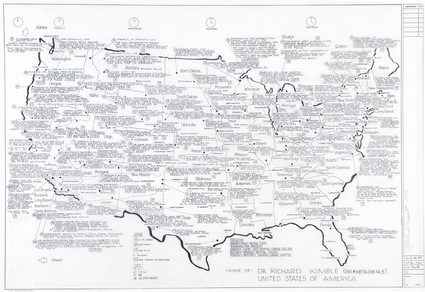 Mark Bennett, Home of Richard Kimble (The Fugitive), 1999
Mark Bennett, Home of Richard Kimble (The Fugitive), 1999
In 1988, Cheng installed a giant concrete roller on the beach in Santa Monica. The roller is engraved with inverse 3D plates that print a map of Los Angeles in the sand.
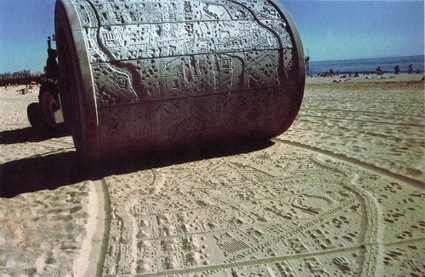 Carl Cheng, Santa Monica Art Tool, 1988 (image)
Carl Cheng, Santa Monica Art Tool, 1988 (image)
Related stories: Conflux 2008: notes from the panel Cartography of Protest and Social Changes, Situation Room, You Are Not Here, Exploded Views – Remapping Firenze, Real Time Rome.
Related books: Book Review – An Atlas of Radical Cartography, Experimental Geography: Radical Approaches to Landscape, Cartography, and Urbanism.
